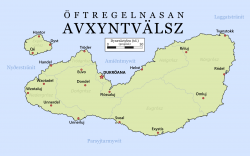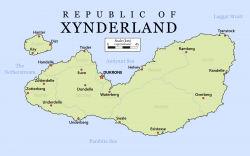Xynderland
| Republic of Xynderland Öftregelnasan Avxyntvälsz |
||||
|---|---|---|---|---|
|
||||
| Anthem: Unner Jyrenne | ||||
The map of Xynderland (Xynder)
|
||||
The map of Xynderland (English)
|
||||
| Capital | Dukrone | |||
| Largest | Zotterberg | |||
| Official languages | Xynder | |||
| Recognised national languages | Nithalos, Laefevian, Edievian | |||
| Recognised regional languages | Exgot, Highland Xynder | |||
| Demonym | Xynderian | |||
| Government | ||||
| - | President | Krystianen Primevus Kröaning | ||
| Area | ||||
| - | 29,573 km2 11,418 sq mi |
|||
| - | Water (%) | 4.2 | ||
| Population | ||||
| - | estimate | 5941728 | ||
| - | Density | 200.9/km2 520.3/sq mi |
||
| HDI | 0.762 high |
|||
| Time zone | SCT (SCT+1) | |||
| Date format | DD/MM/YYYY | |||
| Drives on the | left | |||
Xynderland (IPA: English pronunciation: /ˈzɪndɜrlænd/, Xynder: Avxyntvälla, IPA: [ˈäu̯zɪntˌvælːä]), officially the Republic of Xynderland, is an island located in the middle of the Amiyant Sea near the Netherstream just off the coast of the Šarkunen Peninsula. Its closest neighbour is Seret, Nithalosia, with further neighbours such as Laefevia and Edievia.
Xynderland was also one of the founding members of the Union of Šarkunen Nations
Etymology
Having once been under Laefevian rule, the term Avxynt originally came from the words av (out) and Xynt (person) which originally came to mean foreigner, thus Avxyntvälla meant land of the foreigners. This was because the word Xynt became the word for someone of the mainland, which was, at the time, considered Laefevia. After being separated, Xynderland retained this name. Nowadays, Avxynt is simply used in Xynder to refer to a Xynden.
A similar name appeared in Laefevian, âsitti (?), originally deriving from the word for foreign.
History
Secession of the Kingdom of Xynderland
Xynderland's history stretches back to 916, when the Kingdom of Xynderland seceded from the Laefevia, following the rise of a prominent king, namely King Thorin Dyring. The separation followed a Xynderian resistance which the Laefevian forces did not like and attempted to put down; though at the time, Laefevia had many other issues at hand and overlooked the secession of Xynderland. The Kingdom was then ruled under the Dyring Royal Family for the following 700 years.
Xynderian Civil War
The Xynderian Civil War began in 1637 with an uprising against King Vai Dyring II. The two year conflict became a symbolic event in Xynderian history, being the fall of a reign described by some as tyranny. During the war, around half of the population residing in the modern-day Donder District immigrated to Southern Mereland, who had opened their borders to migrants. A majority of those left in the Donder district were arrested or killed if they displayed any resistance or aided anybody in escaping to Mereland. Many villages around Xynderland were burnt down; this often set fire to the surrounding forest, resulting in the death of many native tribes.
The end of the war established the Republic of Xynderland, lead by the first president Hjenner Sylging.
Geography
Geology
Climate
Biodiversity
Politics
Government
Administrative divisions
Foreign relations
Military
Economy
Transport
Energy
Science and technology
Tourism
Demographics
Ethnic groups
Urbanisation
Language
Education
Healthcare
Religion
Culture
City trees
City trees (Xynder: Hvöiren, IPA: [ˈθvøɪɾ-ɛn]) are usually big and very old trees found in or near to the centre of most cities in Xynderland. It is said that the type of tree can say a lot about its city's people and past. A few centuries ago, they contained the honour and pride of a city, and was usually what brought the city together for festivals and other communal events. Quite far in history they even used to be worshipped and were seen as protectors of a city. During Xynderland's kingdom days, part of the punishment of treason was to have the city tree of the offender's home cut down, both as a symbol of power and to assure shame and dishonour towards the individual. When the Revolution happened, the city tree of the contemporary capital Euvo was cut down and called "corrupt" to reflect the opinions towards the then-dead king. Nowadays they are still heavenly respected by the inhabitants, and are commonly seen a symbol of respect for those who have passed away.
Most city trees will possess a fairly large preserved area around them of empty field, serving as a reminder of the Xyndens' strong and historical connection with the beauty of nature even prior to urbanisation. Most city children will often gladly enjoy their time outside by the tree. The large area provides great opportunities for gatherings and most Xynden will get married under the tree before the city's people. Thus most people within a Xynderian city are very close and get along just as well as those who live in the countryside.
The trees' heart-warming significance means that in the rare cases they do get destroyed such as during heavy storms, it warrants the mourning of the entire city and even calls for national silence at times. Being seen attempting to destroy or deface the tree will in most occurrences result in one's immediate arrest. If somehow one manages to destroy a city tree without yet being apprehended, they are in accordance with historical law charged with treason. Despite this, the punishment for treason no longer has changed to exclude death and the felling of one's home-tree. This protectiveness of the trees seen in Xynden often confuses those not native to the culture.


